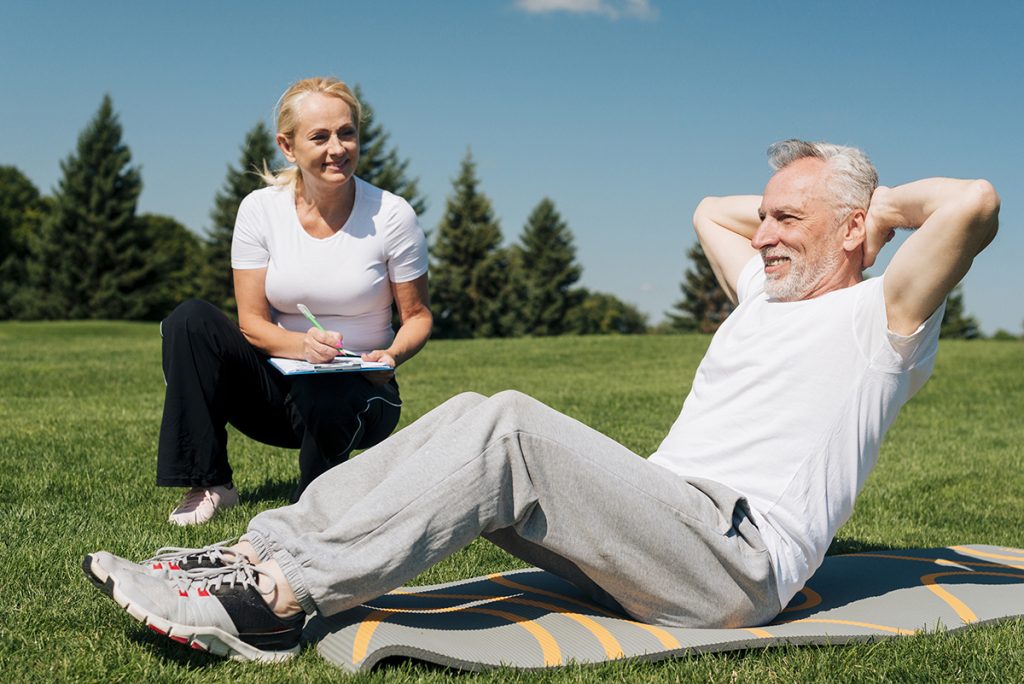
Table of Contents
The American College of Sports Medicine says that 1.2 million adults in the U.S. are disabled by lower back pain on any day, and most are due to mechanical causes. Mechanical causes mean the pain develops from overloading or injuring the back. Exercise is one of the key elements of a treatment plan for back pain. You do not have to be a sports participant or athlete to injure or stress your back in the cervical, thoracic, or lower back regions. You can experience back pain just by making common exercise mistakes.
Exercise Excesses
Exercise is like medicine. It can deliver important benefits for health and well-being. Also like medicine, exercises can cause harm when not used correctly. As the U.S. Department of Health and Human Services points out, most people hurt their backs when lifting, pulling or pushing something that is too heavy. Knowing this, it is not surprising that millions of people experience back pain from working out.
Poor exercise habits can cause or increase back pain. If you do not know how to exercise with a bad back, there is a good chance you will aggravate an existing spinal condition, like arthritis, or injure your back in the spine or the supporting soft tissues. The result is more pain instead of less.
10 Common Exercise Mistakes
As mentioned, exercise can relieve or cause back pain. The key is avoiding the common mistakes people make in their desire to get fit or address an existing medical condition. Following are 10 common reasons people experience back pain after exercise.
1. Not regularly exercising
Many people go hot and cold while exercising. They exercise for a while and then quit. The body deconditions after stopping exercising. Upon returning to an exercise routine, they start at a higher level than their body is prepared to handle. The result is back pain quickly develops due to a lack of core and back muscle strength, or spinal joints are stressed.
2. Lifting weights that are too heavy
Back pain after weight lifting is common, and often due to using weights that are too heavy. People who enjoy exercising like to show they are improving and start adding more weight sooner than their back is ready to handle. Unknowing beginning exercisers also may begin with too much weight. Once you can comfortably do 12 repetitions with a particular weight, only then add weight.
3. Using poor posture and lifting technique when using weights
Adding to the problem of using excessive weight is the use of poor lifting posture that causes injury to the muscle and ligaments, especially in the lower back. A rounded back puts the hips at an angle which creates more stress and strain. In addition, never use momentum to move the weights. Always stay in control of the weights. If you experience lower back pain after exercise, it could be a combination of poor posture, poor lifting technique and too much weight.
4. Performing the same motions repeatedly
Doing the same exercises over and over again puts the focus on one muscle group. This can cause muscle and other soft tissue inflammation in the back. Also, should you suddenly add new exercises, the conditioned muscle group is suddenly stressed by trying to manage new positions. It is best to do a variety of exercises that work various muscles, tendons and ligaments.
5. Using gym equipment improperly
There is an unlimited number of ways to develop back pain working out just by making the wrong moves on gym equipment. For example, it is easy to injure the shoulder and neck joints with pulldowns behind the neck because it compresses the joints and does not leave much room for the joint to move. Other moves that can lead to back pain include over-arching the back during shoulder presses and bench pressing weights while failing to keep core muscles engaged for stability, to name two.

6. Ignoring core muscles
The core muscles play an important role in maintaining back health. The core muscles include the front abdominal muscles, muscles on the side of the body, the transverse abdominal that wraps around your front and the back muscles that run along the spine.
These deep muscles perform unique functions, and exercise program design research has found that strengthening these muscles through exercise should be a progressive plan – stability, mobility, endurance, strength and final power moves. Failing to build strength in core muscles can lead to back pain because the body will rely more on passive structures, like ligaments, and on spinal discs.
7. Improper form during recreational activities
MedlinePlus offers advice on back pain and sports or recreational activities. It notes that all exercises stress the spine to some degree, so knowing how to do your favorite recreational activities with good form can help you avoid results like compression of the spine (bicycling), forceful rotation of the spine (golf), jarring of the spinal disks and small back joints (running) and overextending the back tissues (tennis). Though these activities are enjoyable, it is important to learn proper techniques to avoid developing conditions like sciatica.
8. Not stretching before exercising
Stretching before exercising produces a number of beneficial results. First, it warms up the muscles, tendons and ligaments by increasing blood flow. Second, it increases tissue flexibility. It also reduces muscle stress, increases oxygen flow and aligns the joints. All of these results reduce the chance of developing back pain. Just as important is the fact that stretching consistently can help reduce chronic pain that currently exists due to back injuries, fibromyalgia, SI joint dysfunction and many other conditions.
9. Thinking a back is flat when it is not
In the “old days,” people were told to lock the back in a supported position of “chest out, butt out” while squatting. Now it is known these are poor mechanics that place a load on the facet joints. Instead of tilting the pelvic too much, open the hips, align the body and hip hinge with a true flat (keep shins perpendicular to the ground and the spine aligned) back to reduce back stress and the risk of a herniated disc. Actually, using proper body mechanics is essential to every exercise, sports and recreational activity you perform.
10. Doing sit-ups and crunches
The National Spine Health Foundation reports that traditional sit-ups impose 3,300 N of spine compression. Doing repetitive sit-ups places a repetitive load on the spine which leads to higher injury rates. An annual fitness test study in the military found that people doing planks had healthier spines than those doing sit-ups because the submaximal microtrauma that leads to inflammation in the lumbar spine was avoided.

More Exercise, Not Less
You can exercise with back pain. The key is to avoid common exercise mistakes.
In the article “Exercise in the Management of Chronic Back Pain,” researchers reviewed medical recommendations for managing acute and chronic back pain. The review revealed that medical societies around the world have recommended more, not less, activity as part of the treatment plan for recovery and to ease back pain. Physical therapy includes exercises because it increases function. Bottom line: You should exercise with back pain.
The key, say the authors, is for a clinical treatment program to be pragmatic in that it follows a principle of progressive overload. In other words, the exercise slowly increases in intensity, frequency and/or duration to bring improvement. This has proven to be advice now consistently given to people to avoid causing back pain or to reduce back pain due to disease or injury.
Think “pragmatic” the next you find yourself asking, “Could I injure my back if I pick up this heavier weight or perform this exercise without instruction on the proper form?” The risk of incurring back pain is not worth overdoing exercising or not taking the time to learn how to avoid common exercise mistakes.
Sources
- https://www.exerciseismedicine.org/support_page.php/lower-back-pain/
- https://health.gov/myhealthfinder/topics/everyday-healthy-living/safety/prevent-back-pain#panel-2
- https://www.betterhealth.vic.gov.au/health/HealthyLiving/resistance-training-preventing-injury
- https://journals.lww.com/nsca-scj/Fulltext/2010/06000/Core_Training__Evidence_Translating_to_Better.4.aspx
- https://medlineplus.gov/ency/patientinstructions/000519.htm
- https://www.painpathways.org/the-important-benefits-of-stretching-for-pain-relief/
- https://www.ncbi.nlm.nih.gov/pmc/articles/PMC3963038/
